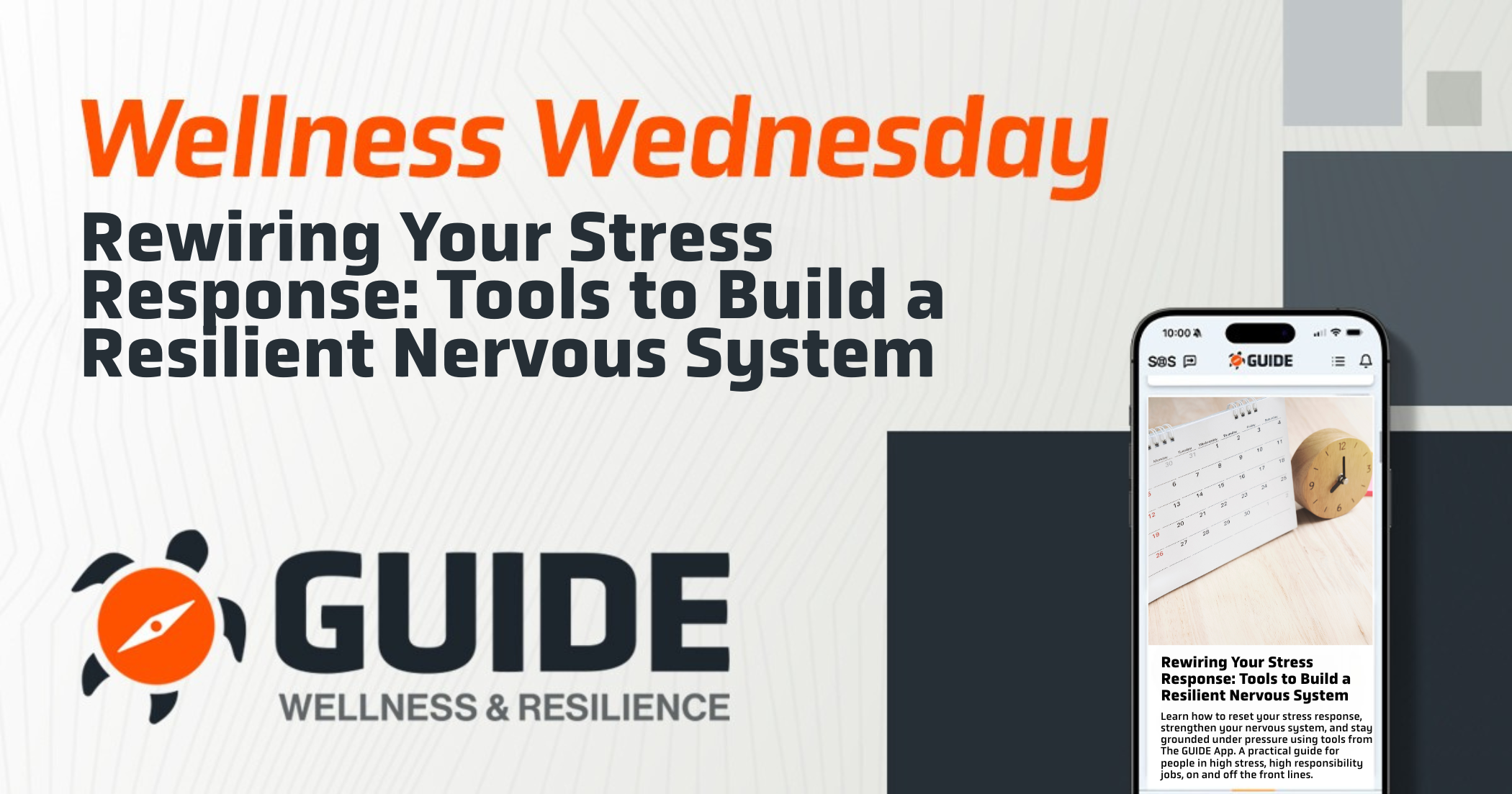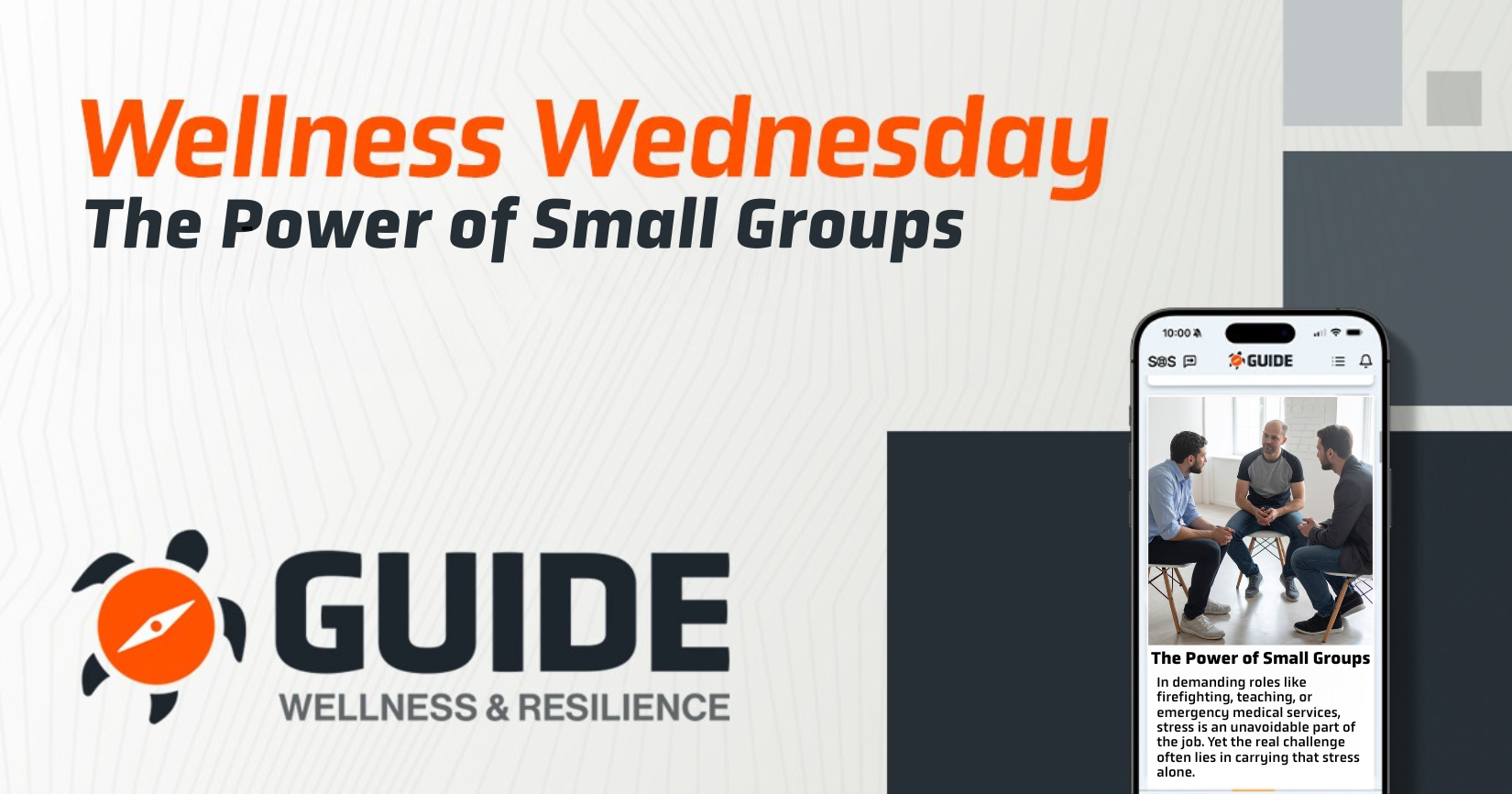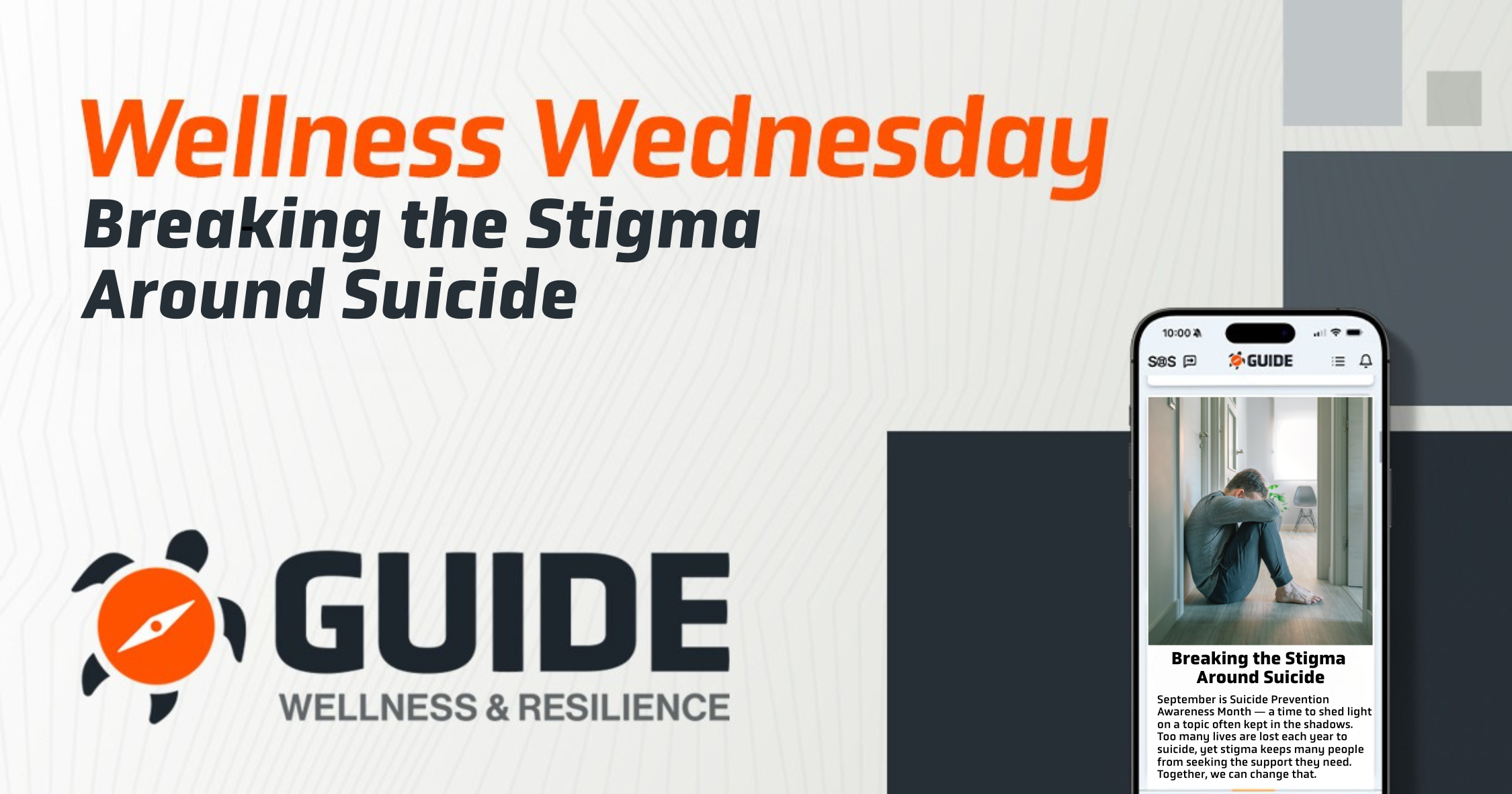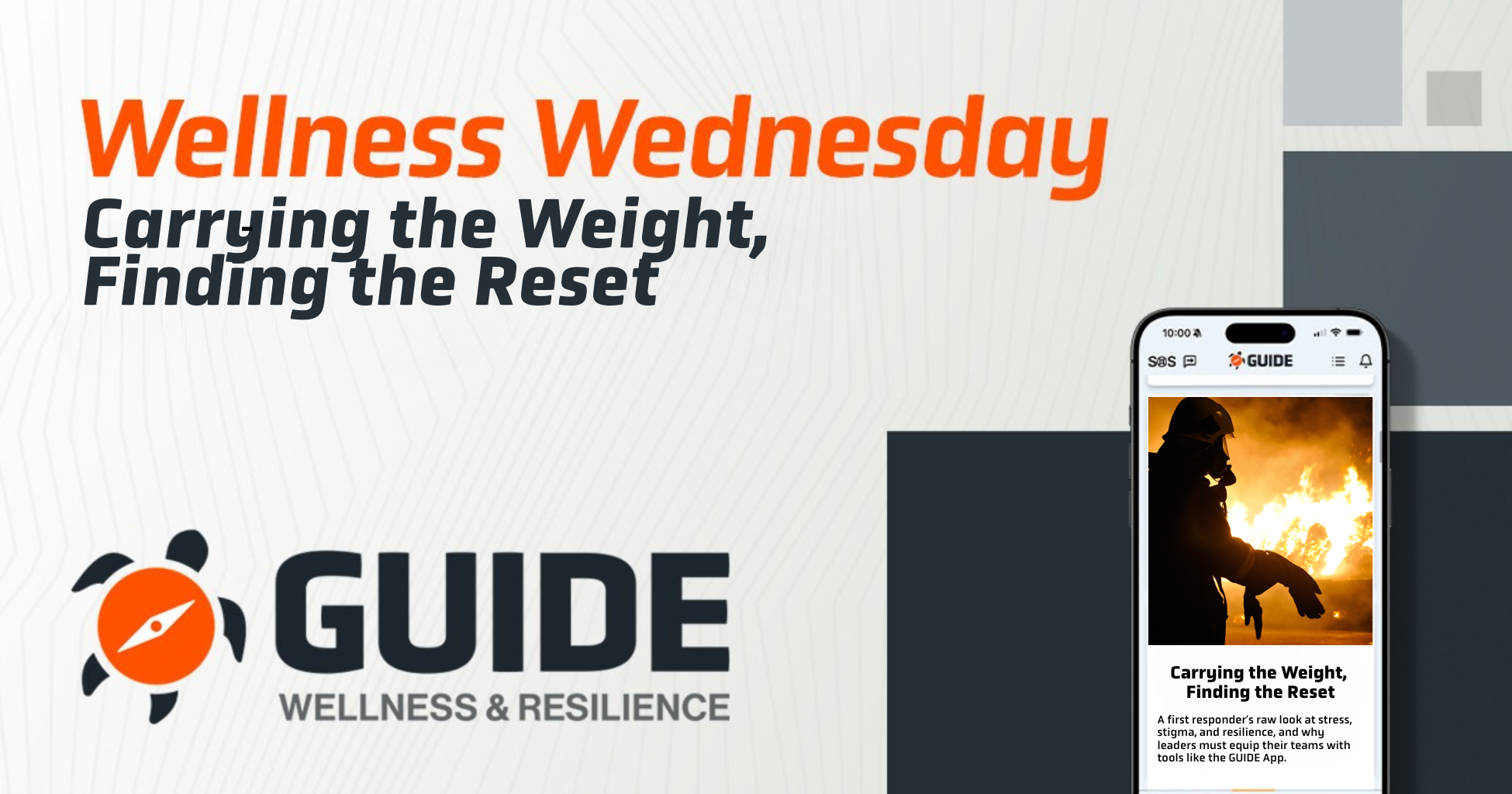For Those Who Serve Others, On and Off the Job
Stress isn’t just something you feel, it’s something your body remembers. Every call, every decision, every long shift, every moment where you had to stay calm while others couldn’t… it all adds up. If you’re in a role where others rely on you, whether that’s in public safety, healthcare, the classroom, or behind a counter, you know what this feels like.
This week’s Wellness Wednesday from The GUIDE App is all about learning how to reset that response. To retrain your nervous system so that you can stay grounded in high-stress moments—and recover afterward without carrying it into your home, your relationships, or your sleep.
We’ll walk you through how stress affects the body, how to spot the signs that your system is stuck, and how The GUIDE App can help you build resilience using science-backed tools like mood tracking, breathing, grounding, and daily micro-practices.
Stress Response 101: What It Is and Why It Matters
Your body’s stress response is an ancient system designed to help you survive threats. It’s fast, powerful, and automatic.
When something stressful happens, your sympathetic nervous system activates, triggering the “fight, flight, or freeze” response. Your heart rate spikes. Your breathing quickens. Muscles tense. You get tunnel vision and short-term focus.
It works great in emergencies. But when you’re living and working in a high-stress environment, your body can get stuck in that mode, long after the danger has passed.
That’s when problems show up:
- You can’t sleep, even when you’re exhausted
- You snap at people you care about
- You’re either shut down or constantly on edge
- You feel wired and tired at the same time
This is nervous system dysregulation, and it’s more common than you think.
The good news? Resilience is trainable. And you don’t need to overhaul your life to get there.
First Step: Learn to Recognize What Stress Feels Like for You
Stress doesn’t look the same for everyone. That’s why awareness is your first tool. The GUIDE App’s mood tracking feature helps you track patterns, reflect on triggers, and see what’s helping, and what’s not.
You might notice:
- You’re more anxious on certain days or after certain people
- Your mood lifts when you use grounding techniques
- You crash after stretches of powering through
Tracking your mood each day helps you take ownership of your stress, not just manage symptoms after they hit. It also helps the app tailor content to your real-time needs.
The Nervous System: Fight, Flight, Freeze, and Reset
Let’s break down how your body responds to stress:
- Sympathetic system (fight or flight): Reacts to threat. Boosts energy, sharpens focus. Meant for short bursts.
- Parasympathetic system (rest and recover): Brings you back to calm. Supports digestion, healing, sleep, and clarity.
We need both systems to function well. But when the sympathetic side dominates too long, the body stays in a heightened state. That’s where burnout, anxiety, and chronic fatigue come in.
Signs your system may be dysregulated:
- Trouble falling or staying asleep
- Feeling overwhelmed by small tasks
- Physical tension or pain with no clear cause
- Mood swings or numbness
- Reacting with anger or shutdown when stressed
You can’t “think” your way out of these symptoms. But you can retrain your system.
The GUIDE App Tools to Rewire Your Response
Here’s where the real work, and change, happens. The GUIDE App gives you access to tactical, research-backed tools that help build nervous system resilience from the inside out.
1. Breath Control
One of the fastest ways to reset your nervous system is through your breath.
Inside The GUIDE App, you’ll find guided:
- Box Breathing
- Tactical Breathing
- Rhythmic Breathwork for Focus and Calm
These exercises are used by elite operators, pro athletes, and trauma experts. Practicing just 3–5 minutes a day can shift your body out of fight-or-flight and into calm and control.
Pair breathwork with mood tracking and note how your stress levels respond over time.
2. Grounding Practices
When stress takes over, grounding brings you back into your body. The GUIDE App includes:
- 5-senses grounding walkthroughs
- Progressive muscle relaxation
- Body scans for tension release
- Visual grounding prompts for shift work or off-duty recovery
Grounding isn’t complicated. It’s the practice of anchoring yourself to the here and now. You can do it in the locker room, in the break room, or before bed. The key is using it consistently so your body learns what calm feels like again.
3. Daily Micro-Practices
Small habits lead to lasting change. That’s why The GUIDE App offers daily wellness challenges, mental fitness tools, and journaling prompts you can complete in under five minutes.
You’ll find:
- Reflective prompts on purpose, energy, and relationships
- Visualization sessions for shift transitions or stress prep
- Stress debrief tools to process tough calls or moments
- End-of-day resets for sleep and reflection
Each practice builds on the next. And over time, they rewire how your brain and body respond to daily pressure.
4. Mood Tracking
As mentioned earlier, mood tracking is more than a diary. It gives you data. When you track your mood every day, you start to see:
- What tools help the most
- What times of day or shifts feel hardest
- Where emotional fatigue is creeping in
The app uses this info to adjust what it recommends to you. It’s all private, secure, and designed to support—not shame—you.
5. Badges and Progress Markers
Every time you show up, you’re building resilience. And The GUIDE App tracks that progress with visual achievement badges that recognize consistency, effort, and engagement.
You don’t need to post them, share them, or compete with anyone. These markers are just for you, to serve as a quiet reminder that you’re putting in the work to feel better, show up stronger, and take control of your stress.
If You Don’t Use It, It Can’t Help
This is the part most people need to hear clearly:
The GUIDE App only works if you use it.
No one tool can change your life overnight. But if you open the app, track your mood, try the practices, and return to it when things feel off, you’ll build a nervous system that bends but doesn’t break.
- You’ll notice stress before it takes over
- You’ll know what to do when your body starts to react
- You’ll have strategies that actually work in the real world
And if you’ve been feeling stuck or numb for a while, just opening the app is a win. Start small. Stay curious.
Progress Doesn’t Always Look Like Progress
It’s easy to miss your own growth. Here are subtle signs your stress response is getting stronger:
- You pause before reacting
- You ask for what you need without guilt
- You move your body even when it feels easier to shut down
- You fall asleep a little faster
- You take a breath, not just out of habit, but out of skill
None of this is accidental. It’s you, putting in the work. And The GUIDE App is here to help every step of the way.
Your 7-Day Nervous System Reset Plan
Try this simple structure to reset your stress response this week:
Day 1 (Monday)
- Open the app
- Track your mood
Day 2 (Tuesday)
- Use a grounding practice during a stressful moment
- Reflect on how your body felt before and after
Day 3 (Wednesday)
- Read the weekly Wellness Wednesday post
- Journal for 3 minutes using a prompt from the app
Day 4 (Thursday)
- Repeat a breathing or grounding technique
- Check your badge progress
Day 5 (Friday)
- Try a short visualization exercise
- Note your energy or mood change afterward
Day 6 (Saturday)
- Rest or reset with a movement practice (stretch, walk)
- Use mood tracking to reflect on your week
Day 7 (Sunday)
- Review your badges or usage streak
- Set a simple intention for the week ahead
Final Thoughts: This Is Training, Not Therapy
You don’t need a diagnosis to deserve support. If you’re out there holding space for others, keeping the shift moving, keeping your team safe, holding the emotional weight of strangers, you deserve tools that help you stay well.
The GUIDE App isn’t therapy. It’s tactical mental fitness for people who serve others. Whether you’re in uniform or behind a counter, in the classroom or behind the wheel, you deserve recovery, too.
You’re not broken. You’re not behind. You’re training.
And like any training, it takes reps.
So open the app. Breathe. Track how you feel. And show up again tomorrow.
You’re building something stronger than toughness. You’re building resilience.




